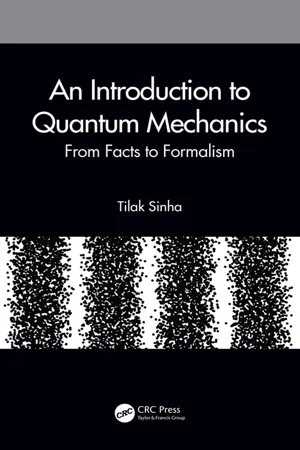
- 264 pages
- English
- ePUB (mobile friendly)
- Available on iOS & Android
About This Book
The core content of even the most intricate intellectual edifices is often a simple fact or idea. So is it with quantum mechanics; the entire mathematical fabric of the formal description of quantum mechanics stems essentially from the fact that quantum probabilities interfere (i.e., from the superposition principle ). This book is dedicated to substantiating this claim. In the process, the book tries to demonstrate how the factual content of quantum mechanics can be transcribed in the formal language of vector spaces and linear transformations by disentangling the empirical content from the usual formal description. More importantly, it tries to bring out what this transcription achieves.
The book uses a pedagogic strategy which reverse engineers the postulates of quantum mechanics to device a schematic outline of the empirical content of quantum mechanics from which the postulates are then reconstructed step by step. This strategy is adopted to avoid the disconcerting details of actual experiments (however simplified) to spare the beginner of issues that lurk in the fragile foundations of the subject.
In the Copenhagen interpretation of quantum mechanics, the key idea is measurement. But "measurement" carries an entirely different meaning from the connotation that the term carries elsewhere in physics. This book strives to underline this as strongly as possible.
The book is intended as an undergraduate text for a first course in quantum mechanics. Since the book is self contained, it may also be used by enthusiastic outsiders interested to get a glimpse of the core content of the subject.
Features:
-
- Demonstrates why linear algebra is the appropriate mathematical language for quantum mechanics.
-
- Uses a reconstructive approach to motivate the postulates of quantum mechanics.
-
- Builds the vocabulary of quantum mechanics by showing how the entire body of its conceptual ingredients can be constructed from the single notion of quantum measurement.
Frequently asked questions
Information
Chapter 1
Theoretical Framework - A Working Definition
What Is a Theory?
Formal Description of a Theory
The deaf composer
Formal description in the natural sciences
Table of contents
- Cover
- Half Title
- Title Page
- Copyright Page
- Dedication
- Contents
- Preface
- Prologue
- 1 Theoretical Framework - A Working Definition
- 2 The Empirical Basis of Quantum Mechanics
- 3 States as Vectors
- 4 Observables as Operators
- 5 Imprecise Measurements and Degeneracy
- 6 Time Evolution
- 7 Continuous Spectra
- 8 Three Archetypal Eigenvalue Problems
- 9 Composite Systems
- A Probability
- B Linear Algebra
- Bibliography
- Index